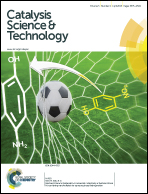Soluble polymer-supported hindered phosphine ligands for palladium-catalyzed aryl amination†
Abstract
Strategies for synthesis of more effective soluble supported ligands for phosphine-ligated Pd(0) cross coupling catalysts have been explored. Reversible addition-fragmentation chain transfer (RAFT) polymerization has been used to prepare alkane-soluble poly(4-alkylstyrene)-bound phosphine ligands. 4-tert-Butylstyrene and 4-dodecylstyrene were copolymerized with ca. 7 mol% of 4-chloromethylstyrene or a 4-diphenylphosphinestyrene monomer using RAFT chemistry to afford poly(tert-butylstyrene-co-4-dodecylstyrene) copolymers. Polymers with chloromethyl groups were allowed to react with the phenolic group of a hindered dicyclohexylbiarylphosphine ligand. This hindered polymer-bound phosphine formed reactive Pd complexes useful in haloarene amine couplings. All aryl halide amination reactions had Pd leaching that was typically <0.1% of the charged Pd with one example having only 0.02% Pd leaching. These Pd complexes of poly(4-alkylstyrene)-bound phosphines were also compared to similar hindered phosphine complexes formed with a polyisobutylene (PIB), whose terminus was also converted into a dicyclohexylbiarylphosphine ligand. Palladium catalysts ligated by these hindered biarylphosphines on poly(4-alkylstyrene) and PIB-bound both were recyclable in the absence of oxygen, had similar activity, and very low Pd leaching.


 Please wait while we load your content...
Please wait while we load your content...